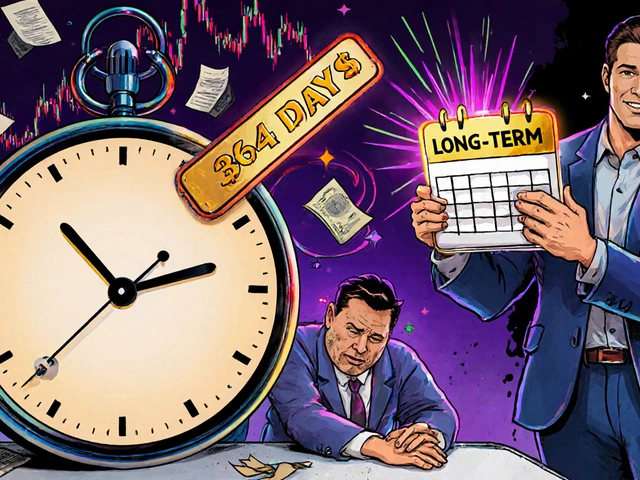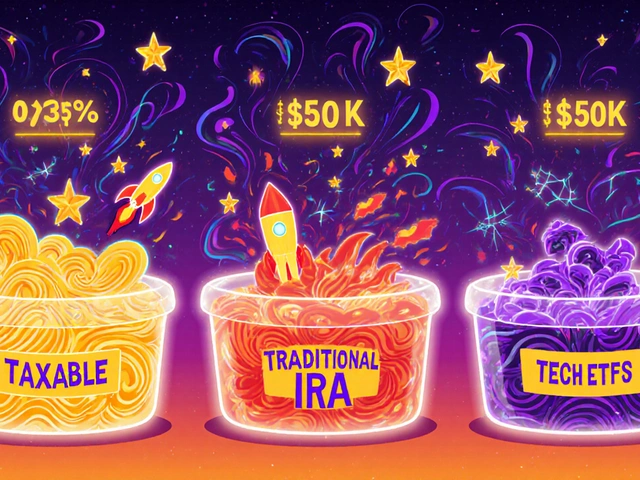Portfolio Cash Flow Rebalancer
Portfolio Rebalancing Calculator
See how much you need to redirect dividends and coupons to maintain your target allocation without selling assets.
Rebalancing Results
Current Cash Flow
$0
Your annual dividends and coupons
Recommended Allocation Adjustment
Estimated Time to Reach Target Allocation: About 2 years (based on current cash flow)
Key Benefit: This approach avoids capital gains taxes and transaction fees by using incoming income to rebalance.
Most people think rebalancing means selling what’s up and buying what’s down. But what if you could rebalance without selling anything at all? What if your dividends and bond coupons did the work for you?
It’s not magic. It’s math. And it’s one of the quietest, most powerful ways to keep your portfolio aligned with your goals-without triggering taxes, paying fees, or second-guessing yourself in a market crash.
Why Selling Isn’t the Only Way to Rebalance
Let’s say your target is 60% stocks and 40% bonds. Over time, stocks surge. Now you’re at 70% stocks and 30% bonds. The textbook fix? Sell 10% of your stocks and buy bonds. Simple. But here’s the catch: you might owe capital gains taxes. You might pay a commission. And you might be selling right before the next big run.
There’s another path: use the cash already coming in.
Every quarter, your stocks pay dividends. Your bonds pay coupons. If you’ve got a taxable brokerage account or a 401(k) with automatic reinvestment, those payments are already landing in your account. Instead of letting them sit as cash or auto-reinvesting them into the same asset, redirect them to the underweight side.
That’s it. No selling. No timing. Just redirecting the money you’re already getting.
How Cash Flow Rebalancing Actually Works
Here’s how it plays out in real life.
Imagine you have a $100,000 portfolio: $60,000 in stocks, $40,000 in bonds. Your stocks pay $1,800 in dividends this year. Your bonds pay $1,200 in interest. That’s $3,000 in cash flow.
Now, after a strong year, your portfolio is 68% stocks, 32% bonds. You’re off target. But instead of selling $6,000 in stocks to buy bonds, you take that $3,000 in dividends and coupons-and you put every single dollar into bonds.
Next year, same thing. More dividends. More coupons. All go to bonds. Over time, you’re slowly pulling your allocation back into line-without ever touching your existing holdings.
This approach is backed by Vanguard’s research using data from 1926 to 2010. Portfolios that rebalanced using cash flows matched the returns of traditional methods but had lower volatility. Why? Because you’re not selling high and buying low-you’re buying low with money you didn’t have to sell anything to get.
The Numbers Don’t Lie
Let’s compare three methods:
- Monthly rebalancing (sell/buy): 8.5% annual return, 12.1% volatility
- Annual threshold rebalancing (sell/buy when off by 5%): 8.6% return, 11.8% volatility
- Cash flow rebalancing (use dividends/coupons only): 8.5% return, 11.3% volatility
The difference? A 0.5% drop in volatility. That’s not huge on paper-but over 20 years, it means significantly fewer sleepless nights during market crashes.
And in taxable accounts? Cash flow rebalancing beats threshold-based selling by 0.3% to 0.7% per year. Why? Because you avoid capital gains taxes entirely. You’re not triggering a taxable event-you’re just letting your income do the work.

When It Works Best
This strategy shines in accumulation phase.
If you’re still working, contributing to a 401(k), or adding money to a brokerage account every month, you’re already building a steady stream of cash. Combine that with dividends and coupons, and you’ve got a natural rebalancing engine.
Take a real example from Reddit: one investor rebalanced a 60/40 portfolio over 24 months using only dividend reinvestment into bonds. Result? $387 in transaction fees avoided. $1,240 in capital gains taxes deferred.
Robo-advisors like Betterment, Wealthfront, and Schwab Intelligent Portfolios now use this exact method. As of 2023, 68% of them do. That’s over $1.2 trillion in assets managed this way.
It’s not just for tech-savvy investors. If your brokerage lets you redirect dividends (and 98% of them do), you can start today.
When It Falls Short
But here’s the reality: cash flow rebalancing isn’t a cure-all.
It depends on cash flow. If your stocks stop paying dividends-like in 2020, when S&P 500 companies cut $230 billion in payouts-you lose your main tool. Same with bonds: if yields collapse (like in 2020, when the 10-year Treasury dipped below 0.5%), your coupon income shrinks. And if your portfolio drifts 15% off target before enough cash accumulates? You’re stuck waiting.
One retiree on Reddit described how, during the 2022 bear market, his bond allocation fell from 40% to 28%. His dividend income dropped 18%. He couldn’t rebalance fast enough-and then he needed to withdraw money to live on.
This method works best when you’re adding money. If you’re taking money out (like in retirement), you’re not adding fuel-you’re draining the tank.
How to Set It Up
Follow these five steps:
- Set your target allocation. Example: 50% U.S. stocks, 20% international, 20% bonds, 10% cash.
- Track your drift. Use a simple spreadsheet. Rebalance trigger? 5 percentage points off target. That’s what Vanguard recommends.
- Know your cash flows. Log every dividend and coupon payment. Most brokerages show this in your account summary.
- Redirect all new cash to underweight assets. If bonds are low, put every dollar of interest and dividends into bonds. If international stocks are underweight, send cash there.
- Review once a year. Check your allocation. If you’re still way off, make a small, targeted sale. But only if you have to.
It takes 3 to 5 portfolio reviews to get comfortable with this. Most people nail it by year two.

What to Avoid
Common mistakes?
- Putting cash flows back into the same asset class because it’s “performing well.” That’s the opposite of rebalancing.
- Ignoring taxes. In taxable accounts, even dividends can be taxable. Make sure you’re not accidentally creating a tax bill by misallocating.
- Waiting too long. If your allocation drifts past 10%, you’re playing catch-up. Cash flow rebalancing works best as a gentle, consistent nudge-not a last-minute rescue.
Pro tip: Use your brokerage’s automated dividend reinvestment settings. Most let you choose where dividends go-not just “reinvest in same stock,” but “reinvest in underweight asset.” If yours doesn’t, switch brokers. It’s worth it.
The Bigger Picture
This isn’t just about avoiding fees. It’s about behavior.
Most investors panic-sell during crashes. Or they chase winners. Cash flow rebalancing removes emotion from the equation. You’re not deciding when to buy or sell. You’re just letting your portfolio’s own income do the adjusting.
And in a world where passive investing dominates, this is the only way to keep your factor exposures alive. As Research Affiliates’ Antti Ilmanen put it: “Dividend streams provide the only organic mechanism to counteract momentum effects in buy-and-hold portfolios.”
Mean reversion works. But only if you’re actively restoring balance. Cash flow rebalancing does that without you lifting a finger.
Final Thought
You don’t need to time the market. You don’t need to pick stocks. You don’t even need to sell anything.
Just let your dividends and coupons do the work.
That’s the quiet power of rebalancing with cash flows.
Can I rebalance my portfolio using only dividends and bond coupons?
Yes. If your portfolio generates enough income from dividends and coupons, you can use that cash to buy underweight assets without selling anything. This avoids taxes and fees. It works best in accumulation-phase portfolios with steady contributions and yields above 2-3%.
Do I need to sell assets to rebalance if I use cash flows?
Not usually. Cash flow rebalancing relies on incoming income to restore balance. But if your allocation drifts more than 10% off target and your cash flows are too slow to catch up, you may need one small, targeted sale. Most investors only do this once a year, if at all.
Is cash flow rebalancing better for taxable accounts?
Yes. It’s especially powerful in taxable accounts because you avoid capital gains taxes. Selling assets triggers taxes. Redirecting dividends and coupons doesn’t. Morningstar found it outperforms traditional methods by 0.3%-0.7% annually in taxable portfolios due to this tax efficiency.
What if my dividends drop during a market crash?
That’s a known risk. In 2020, S&P 500 companies cut $230 billion in dividends. In 2008-2009, dividends fell 23%. When income drops, rebalancing slows. That’s why experts recommend combining cash flow rebalancing with occasional sales during extreme drifts-not relying on it alone during crises.
Can retirees use cash flow rebalancing?
It’s harder. Retirees are withdrawing money, not adding it. Cash flow rebalancing needs incoming cash to work. Many retirees use it as a partial tool-redirecting income when possible-but still rely on occasional sales to rebalance. It’s not a full solution, but it helps reduce taxable events.
Do I need special software or tools to do this?
No. You need a brokerage that lets you redirect dividends (most do), and a simple spreadsheet to track your allocations. Apps like Personal Capital or YNAB can help, but they’re not required. Many investors do this with Excel or even pen and paper.
How often should I check my portfolio for rebalancing?
Check quarterly to track drift, but only act annually unless you’re way off target. Vanguard recommends a 5-percentage-point deviation as your trigger. Most people find that checking once a year is enough when using cash flows, since the process is gradual and steady.
What’s the minimum yield needed for this to work?
Morningstar recommends a minimum portfolio yield of 2-3% annually. Below that, cash flows may be too slow to meaningfully rebalance. In ultra-low-yield environments (like 2020), success rates dropped to 68%. If your yield is low, combine cash flows with occasional targeted sales.






Comments
Bro this is the most underrated strategy ever. I’ve been doing this for 3 years now-no sales, no taxes, just letting my dividends do the heavy lifting. My bond allocation crept up from 35% to 41% without me touching a single sell button. My broker even lets me route dividends to underweight assets-shoutout to Fidelity for actually listening to clients. No more panic-selling during crashes, no more FOMO buying. Just chill and let the cash flow do its thing. Game changer.
Let me be brutally clear: this isn't 'magic math'-it's basic portfolio hygiene. The fact that people still think rebalancing requires active trading is a testament to how badly financial education has been commodified. Vanguard’s data is ironclad: cash-flow rebalancing reduces volatility without sacrificing returns. And in taxable accounts? It’s not just better-it’s morally superior. Why pay the IRS a cut just because someone told you to ‘sell high’? The system is rigged. This is how you weaponize inertia.
It is truly fascinating how the quiet mechanics of compound income can, over time, correct the imbalances that our human impulses create in our portfolios. I have been reflecting deeply on this concept since I first read about it-how the dividends and coupons, these small, regular payments from corporations and governments, are in fact the silent custodians of our financial equilibrium. In a world where we are constantly urged to act, to buy, to sell, to chase, to react-this method asks us to simply observe, to trust the rhythm of the market’s own payments. And yet, many of us, myself included, still feel uneasy when we do not ‘do’ something. Perhaps the greatest discipline is not in the action, but in the restraint. I am now redirecting all my bond coupons into international equities, which have languished for too long. It feels like planting seeds in soil you cannot immediately see. But I believe in the harvest.
Y’all are overthinking this. Just turn off auto-reinvest and point your dividends where you need ‘em. Done. No spreadsheet needed. No PhD in finance. If your broker doesn’t let you do it, switch. Seriously. 98% do. I used to be the guy selling SPY every time it hit 65% and buying BND like it was Black Friday. Now? I just let the money come to me. My portfolio’s been stable for 2 years. No taxes. No fees. No stress. Cash flow rebalancing isn’t a strategy-it’s just common sense with a fancy name.